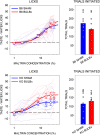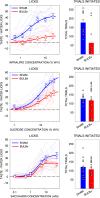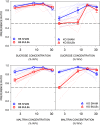Neural Isolation of the Olfactory Bulbs Severely Impairs Taste-Guided Behavior to Normally Preferred, But Not Avoided, Stimuli
- PMID: 32152061
- PMCID: PMC7142272
- DOI: 10.1523/ENEURO.0026-20.2020
Neural Isolation of the Olfactory Bulbs Severely Impairs Taste-Guided Behavior to Normally Preferred, But Not Avoided, Stimuli
Abstract
Here we systematically tested the hypothesis that motivated behavioral responsiveness to preferred and avoided taste compounds is relatively independent of the olfactory system in mice whose olfactory bulbs (main and accessory) were surgically disconnected from the rest of the brain [bulbotomy (BULBx)]. BULBx was confirmed histologically as well as functionally with the buried food test. In brief access taste tests, animals received 10-s trials of various concentrations of a taste compound delivered quasirandomly. BULBx C57BL/6 (B6) mice displayed severely blunted concentration-dependent licking for the disaccharide sucrose, the maltodextrin Maltrin, and the fat emulsion Intralipid relative to their sham-operated controls (SHAM B6). Licking for the noncaloric sweetener saccharin was also blunted by bulbotomy, but less so. As expected, mice lacking a functional "sweet" receptor [T1R2+T1R3 knockout (KO)] displayed concentration-dependent responsiveness to Maltrin and severely attenuated licking to sucrose. Like in B6 mice, responsiveness to both stimuli was exceptionally curtailed by bulbotomy. In contrast to these deficits in taste-guided behavior for unconditionally preferred stimuli, BULBx in B6 and KO mice did not alter concentration-dependent decreases for the representative avoided stimuli quinine and citric acid. Nor did it temper the intake of and preference for high concentrations of affectively positive stimuli when presented in long-term (23-h) two-bottle tests, demonstrating that the surgery does not lead to a generalized motivational deficit. Collectively, these behavioral results demonstrate that specific aspects of taste-guided ingestive motivation are profoundly disturbed by eliminating the anatomic connections between the main/accessory olfactory bulbs and the rest of the brain.
Keywords: affect; gustatory system; olfactory system; reward; smell; taste.
Copyright © 2020 Inui-Yamamoto et al.
Figures










Similar articles
-
T1R2 and T1R3 subunits are individually unnecessary for normal affective licking responses to Polycose: implications for saccharide taste receptors in mice.Am J Physiol Regul Integr Comp Physiol. 2009 Apr;296(4):R855-65. doi: 10.1152/ajpregu.90869.2008. Epub 2009 Jan 21. Am J Physiol Regul Integr Comp Physiol. 2009. PMID: 19158407 Free PMC article.
-
T1R2+T1R3-independent chemosensory inputs contributing to behavioral discrimination of sugars in mice.Am J Physiol Regul Integr Comp Physiol. 2019 May 1;316(5):R448-R462. doi: 10.1152/ajpregu.00255.2018. Epub 2019 Jan 9. Am J Physiol Regul Integr Comp Physiol. 2019. PMID: 30624973 Free PMC article.
-
T1r3 taste receptor involvement in gustatory neural responses to ethanol and oral ethanol preference.Physiol Genomics. 2010 May;41(3):232-43. doi: 10.1152/physiolgenomics.00113.2009. Epub 2010 Feb 9. Physiol Genomics. 2010. PMID: 20145204 Free PMC article.
-
Role of olfaction in the conditioned sucrose preference of sweet-ageusic T1R3 knockout mice.Chem Senses. 2009 Oct;34(8):685-94. doi: 10.1093/chemse/bjp055. Epub 2009 Sep 7. Chem Senses. 2009. PMID: 19736224 Free PMC article.
-
Chorda tympani responses in two inbred strains of mice with different taste preferences.Physiol Behav. 1999 Aug;67(2):287-97. doi: 10.1016/s0031-9384(99)00071-2. Physiol Behav. 1999. PMID: 10477061 Review.
Cited by
-
Selective increases in taste sensitivity to glucose as a function of hunger status.Appetite. 2025 Mar 1;207:107901. doi: 10.1016/j.appet.2025.107901. Epub 2025 Feb 9. Appetite. 2025. PMID: 39933656
-
Gustatory and olfactory-guided responsiveness to maltodextrin solutions in mice.Am J Physiol Regul Integr Comp Physiol. 2025 Jul 1;329(1):R55-R69. doi: 10.1152/ajpregu.00275.2024. Epub 2025 May 17. Am J Physiol Regul Integr Comp Physiol. 2025. PMID: 40380809 Free PMC article.
-
Mechanisms and Functions of Sweet Reception in Oral and Extraoral Organs.Int J Mol Sci. 2024 Jul 5;25(13):7398. doi: 10.3390/ijms25137398. Int J Mol Sci. 2024. PMID: 39000505 Free PMC article. Review.
-
Taste Impairments in a Parkinson's Disease Model Featuring Intranasal Rotenone Administration in Mice.J Parkinsons Dis. 2022;12(6):1863-1880. doi: 10.3233/JPD-223273. J Parkinsons Dis. 2022. PMID: 35848036 Free PMC article.
-
Reduced menthol sensitivity in a prodromal Parkinson's disease model induced by intranasal rotenone treatment.Front Cell Neurosci. 2024 Feb 6;18:1345651. doi: 10.3389/fncel.2024.1345651. eCollection 2024. Front Cell Neurosci. 2024. PMID: 38380382 Free PMC article.
References
Publication types
MeSH terms
Substances
Grants and funding
LinkOut - more resources
Full Text Sources
Molecular Biology Databases
Research Materials
